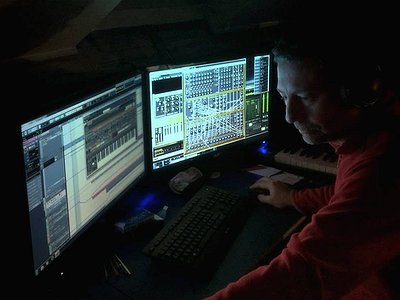Part 2
Could you take us through a day in your life, from a possible morning routine through to your work? Do you have a fixed schedule? How do music and other aspects of your life feed back into each other - do you separate them or instead try to make them blend seamlessly?
I try to allow my family, professional and musical life to coexist in the best possible way. I mean, I try, and I’m not going to hide it from you, it isn’t always simple to manage. Sometimes, I compose in the morning upon waking up, but also and more often in the evening. Other times, I finalize my composition work very late at night, which is not always easy for the people around me. I’m taking this opportunity to thank my family and especially my wife for her patience. She has been instrumental in this musical adventure. I need a certain freedom in order to be capable of openly expressing and magnifying my emotions through my music. It’s a balance that requires particular attention.
Could you describe your creative process on the basis of a piece or album that's particularly dear to you, please? Where did the ideas come from, how were they transformed in your mind, what did you start with and how do you refine these beginnings into the finished work of art?
I can gladly tell you about my last album, ETHEREAL. At the base, I had represented a mystical and very aerial universe. I would describe my compositions as "serious" with a touch of nostalgia. My intention was to integrate the Modular Moog from Arturia in my work for the first time. Therefore, I began to study the different sound approaches for this instrument. I quickly oriented myself towards the use of the modular, as well as its superb sequencer. Its filters are a source of unlimited creation and with subtle automation, it is then possible to nuance the resonances in order to obtain loops that evolve over time. For the three tracks of this album, the modular and its sequencer were used almost identically. The Formant filter (which did not exist on the basic instrument) was a valuable tool for further diversifying the sound modulations of the loops. The next step was the association between the sequences, the pads and the choir. It is precisely in this phase that the sensitivity, the emotions and the tint of the atmosphere, will magnify. It is also the most time consuming part. The compositions of ETHEREAL have been finalized by the mastering varnish, composed of different effects in order to highlight and underline certain details of the soundtrack.
There are many descriptions of the ideal state of mind for being creative. What is it like for you? What supports this ideal state of mind and what are distractions? Are there strategies to enter into this state more easily?
I have to feel well and have the support of my loved ones, so that I can evolve absolutely freely during the process of creation. It’s true that sometimes a simple image, an article or a title will stimulate my imagination. Mysticism, science and spirituality are sources of inspiration for me.
I like imagining notes, sequences, an atmosphere - a musical color. Walking in the forest with my children, for example, will stimulate my creative sphere. Creativity is a state of mind. I don’t calculate, I let it come, and let myself go towards my inspirations in order to fully live my creativity.
How is playing live and writing music in the studio connected? What do you achieve and draw from each experience personally? How do you see the relationship between improvisation and composition in this regard?
To me, studio and live are two totally different things. I must add that being on scene is, for me, something new and very recent. In the studio, I spend hours creating and composing, it’s a familiar environment to me. I have my routines, my landmarks, that allow me to evolve serenely according to my inspirations. My titles are composed with many instruments, tracks and effects. The studio is my house, my home.
Playing live is something else. It’s traveling, meeting with the public, sharing a moment together. I prepare my titles so that these can be exploited on stage. I therefore give the floor to effects, to solos and to improvisation. It’s important for me that I am capable of repeating myself before actually getting on stage. I need a few landmarks - even though deep down I know it's going to be completely different once the stage performance actually begins. There are bound to be imponderables - such is the live game - and that is exactly what will provide the life, spice and emotion that the musician will be able to share in real time with their audience. The contact with their fans is something unique, it’s a special and rewarding experience.
How do you see the relationship between the 'sound' aspects of music and the 'composition' aspects? How do you work with sound and timbre to meet certain production ideas and in which way can certain sounds already take on compositional qualities?
Sound and composition are a unison for me, a musical communion. The two come in pairs. Certain sounds will provide a foundation, a structure to my canvas sound, while others will add a crystalline side - a lightness to the whole. I don’t favor any of the two aspects because, for me, composition and sounds, harmonies and frequencies are complementary. A colorful palette of notes rich in harmonics, and it is a whole musical painting that will be created beneath the musician’s fingers. Going back to my last album, ETHEREAL, it was obvious to me that the Formant filter would play a big role within my compositions. It had offered me rich sounds, in particular when placing the sequences together and it was ultimately an important aspect of this album.
Our sense of hearing shares intriguing connections to other senses. From your experience, what are some of the most inspiring overlaps between different senses - and what do they tell us about the way our senses work? What happens to sound at its outermost borders?
The system of sound interpretation by the brain is a complex process. At my level, I can say that certain sounds will inspire me, touch me or scare me. The interaction between sight and sound corresponds to me. A sound can represent a color in my eyes. The overall color tone of music as a whole would therefore be blue. I appreciate this color that relaxes me and allows me to float above my universe of sounds.
Art can be a purpose in its own right, but it can also directly feed back into everyday life, take on a social and political role and lead to more engagement. Can you describe your approach to art and being an artist?
In my eyes, an artist is a sensitive, receptive being - with an open mind enabling them to evolve, to flourish in creating their artistic universe and thus letting their imagination run wild. For my part, I am happy to share my passion, to offer a part of me. If my music allows listeners to escape from this tumultuous everyday life, then I’ve won my bet :) It's a wonderful adventure.
It is remarkable, in a way, that we have arrived in the 21st century with the basic concept of music still intact. Do you have a vision of music, an idea of what music could be beyond its current form?
My vision is one of music that can be created again and again, above all with the heart. A music that has soul. I hope that in the future, people will still appreciate the work of musicians and that machines will remain a support to their creation and realization.






